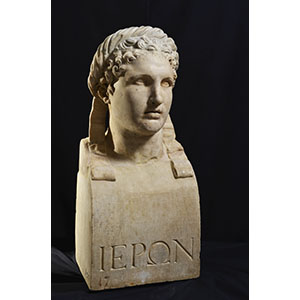Herm of a young deity
The headband circling the temples of this imaginary young head is typical of certain deities and indicates the acquired hero status of poets and philosophers. Pirro Ligorio probably added the inscription "IERON" in Greek letters to a post-Antique nude herm, qualifying the portrait as either Hiero I (478-466 BC), who created a flourishing cultural life in the court of Syracuse by hosting figures such as Aeschylus and Pindar; or Hiero II (308-215 BC), during whose reign Archimedes lived in Syracuse. Ligorio's addition highlights the vibrant Renaissance interest in rediscovering the biographies and faces of Antiquity's illustrious figures.



